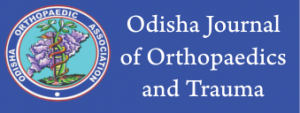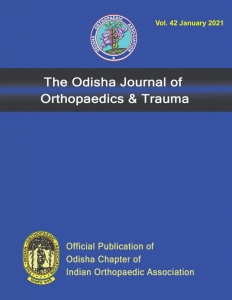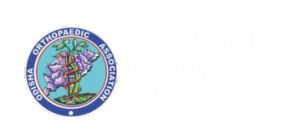Solitary Plasmacytoma of Medial End of Clavicle: A Rare Case Report
Vol 02 | January 2021 | page: 21-23 | Avinash Naik, Saurav N. Nanda, Sourav Kumar Pal, K Srikant, Debashish Mishra
DOI- https://doi.org/10.13107/ojot.2020.v42i01.020
Authors: Avinash Naik [1], Saurav N. Nanda [1], Sourav Kumar Pal [1], K Srikant [1], Debashish Mishra [1]
[1] Department of Orthopaedics, Kalinga Institute of Medical Sciences, Bhubaneswar, Odisha, India.
Address of Correspondence
Dr. Avinash Naik,
Kalinga Institute of Medical Sciences, Bhubaneswar, Odisha, India.
E-mail: dravinashnaik@gmail.com
Abstract
Introduction: Clavicle, an unusual site for an expansile lytic lesion of bone with multiple differential diagnostic possibilities and plasmacytoma being one of them, although reported but very rare. Solitary plasmacytoma of bone(SBP) are a localized bone tumour consisting of plasma cells with no other clinical features that of multiple myeloma. We are presenting such a rare case of solitary plasmacytoma of bone involving the medial end of the clavicle.
Case report: A 40-year female presented with complaints of pain and swelling in the inner aspect of the left clavicle since 2 months. Radiographs showed a lytic expansile lesion involving the medial end of the clavicle and confirmed with CT scan. FNAC was inconclusive and hence excisional biopsy done with a provisional diagnosis of giant cell tumour (GCT). Histopathology features suggestive of plasma cell neoplasm like nodules of plasma cells with an enlarged nucleus and also IHC quantified plasma cells with stains for kappa and lambda. Skeletal survey, serum and urinary electrophoresis, alkaline phosphatase, haemoglobin, renal function test, ESR, CRP, serum calcium and phosphate levels were within normal limits. Bone marrow biopsy also ruled out the possibility of multiple myeloma hence a possible diagnosis of solitary plasmacytosis of bone was made. The patient was further evaluated by oncologists and subsequently, radiotherapy was given. The patient has been in regular follow up for 2 years with no signs of recurrence and multiple myeloma.
Conclusion: Clavicle, although an unusual site of primary bone tumour, should be kept in mind for any swelling around it. Plasmacytoma should also be considered as a differential along with other commoner differentials like GCT, fibrous dysplasia for osteolytic expansile lesions in the clavicle. Multiple myeloma should be ruled at presentation and at long term regular follow-ups to be considered as solitary plasmacytoma of bone after histopathological diagnosis.
Keywords: Plasmacytoma; Clavicle.
References
1. Dr. Chinmay Biswas, Dr. Chinmay Biswas, Dr. Abhradip Mukherjee, Dr. Soumen Roy, 2016. “Solitary Plasmacytoma of clavicle: A rare case report”, International Journal of Current Research, 8, (01), 25387-25389.
2. Jaffe ES, Harris NL, Stein H, Vardiman JW (2001) World Health Organization Classification of Tumours: Pathology and Genetics, Tumours of Haematopoietic and Lymphoid Tissues. Ann Oncol 13: 490-491.
3. Panagopoulas A,Megas P,Kaisidis A,Dimakopoulos P(2006)Radiotherapy Resistant Solitary Bone Plasmacytoma of clavicle.European journal of Trauma 32:190-193.
4. Nirmalesh M & Indranil C & Palash K M & Bidyut K G.(2018).Cytohistopathological Diagnosis of Solitary Plasmacytoma of Clavicle: A Rare Site for a Rare Tumor. Biomed Journal of Scientific & Technical Research. 2. 10.26717/BJSTR.2018.02.000660.
5. Kleins, Kuppers R (1999) The New England Journal of Medicine. 341: 1520.
6. Shahid M,Hali NZ,Mubeen A,Zaheer S,Julfiqar(2010)Solitary Plasmacytoma of Clavicle-A rare case presentation.J Cytol Histol 1:103.doi:10.4172/2157-7099.1000103.
7. Dimopoulos, M.A., Moulopoulos, L.A., Maniatis, A., et al. 2000. Solitary plasmacytoma of bone and asymptomatic multiple myeloma. Blood, 96:20372044
| How to Cite this Article: Naik A, Nanda SN, Pal SK, Srikant K, Mishra D| Solitary Plasmacytoma of Medial End of Clavicle: A Rare Case Report | Odisha Journal of Orthopaedics and Trauma | January 2021; 02: 21-23. https://doi.org/10.13107/ojot.2020.v42i01.020 |
(Abstract Text HTML) (Download PDF)



